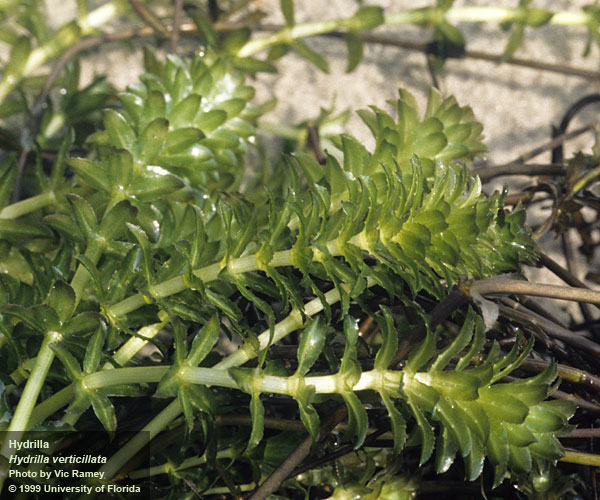
by Rick O'Connor | Sep 1, 2021
EDRR Invasive Species
Hydrilla (Hydrilla verticillata)

Hydrilla Photo Credit: Vic Ramey, UF/IFAS Center for Aquatic and Invasive Plants
Define Invasive Species: must have ALL of the following –
- Is non-native to the area, in our case northwest Florida
- Introduced by humans, whether intentional or accidental
- Causing either an environmental or economic problem, possibly both
Define EDRR Species: Early Detection Rapid Response. These are species that are either –
- Not currently in the area, in our case the Six Rivers CISMA, but a potential threat
- In the area but in small numbers and could be eradicated
Native Range:
India.
Introduction:
Intentionally introduced in 1950-51 as a plant for aquariums.
EDDMapS currently list 3,592 records of this plant in the U.S. and Canada. Most are east of the Mississippi River. There are 370 records in Florida (certainly underreported) and 91% of those are in central and south Florida. There are only 33 records in the Florida panhandle but none of those are within the Six Rivers CISMA (Escambia, Santa Rosa, Okaloosa, Walton, Holmes, and Washington counites. There are four records from the Mobile delta, which lies in Baldwin County Alabama and is part of Six Rivers.
Description:
This is a submerged aquatic plant that will grow up to and across the surface of freshwater habitats. It can grow to lengths of 20 feet. Small whorled, saw-toothed, and pointed green leaves grow from the stem. Small solitary white flowers grow from extended threadlike stalks coming from the stems and resting on the surface. Can form dense mats at the surface.
Issues and Impacts:
The fast growing dense mats of Hydrilla block out sunlight needed by native submerged plants and cause their decline. These thick mats can reduce the natural flow of rivers and springs it invades altering the hydrology and ecology of the system, often reducing the dissolved oxygen levels. It has been known to clog irrigation and flood control canals as well as actually impede boating on some waterways.
The plant is extremely hardy being found in canals and ditches as shallow as a few feet to rivers, lakes and springs up to depths of 20 feet.
It is listed as a Florida Noxious weed and is prohibited from being sold.
Management:
Small infestations can be removed by hand or pulling out using a rake. The plant should be placed in a location where it can completely dry out and die. Those who can manage the levels of their lakes and ponds and draw down the water and kill the plant that way.
For larger infestations of lakes and springs, mechanical “mowers” can be used to cut and remove large areas of the plant. The removed pieces are then deposited into trucks on shore for further desiccation and disposal. Large mats not removed can increase hypoxia in the waterway. One issue with this method is fragments that are missed can generate into new plants.
There are six insects and one fish (Chinese Grass Carp) that have been used to biologically control the plant. However, establishment of these insects have been problematic. The Chinese Grass Carp do well on hydrilla but will feed on other aquatic plants and breeding populations could be a problem for the native ecology. Thus, only sterile triploid carp are allowed to be used and only with an FWC permit. Read more about these biological control agents at the reference below2.
There are several chemical herbicides that have had some success. For more information on using those, contact your local county extension office.
If you are in the Florida panhandle area and believe you may have hydrilla, please contact your county extension office to let them know and report the siting to www.EDDMapS.org. If you have questions on how to do this, your county extension office can help.
For more information on this EDRR species, contact your local extension office.
References
1 University of Florida IFAS Center for Aquatic and Invasive Plants. Hyrdilla. https://plants.ifas.ufl.edu/plant-directory/hydrilla-verticillata/.
2 Biological Controls. Plant Management in Florida Waters: An Integrated Approach. 2021. Center for Aquatic and Invasive Plants. University of Florida IFAS. https://plants-archive.ifas.ufl.edu/manage/control-methods/biological-control/.
Early Detection and Distribution Mapping System (EDDMapS)
https://www.eddmaps.org/
Six Rivers CISMA
https://www.floridainvasives.org/sixrivers/
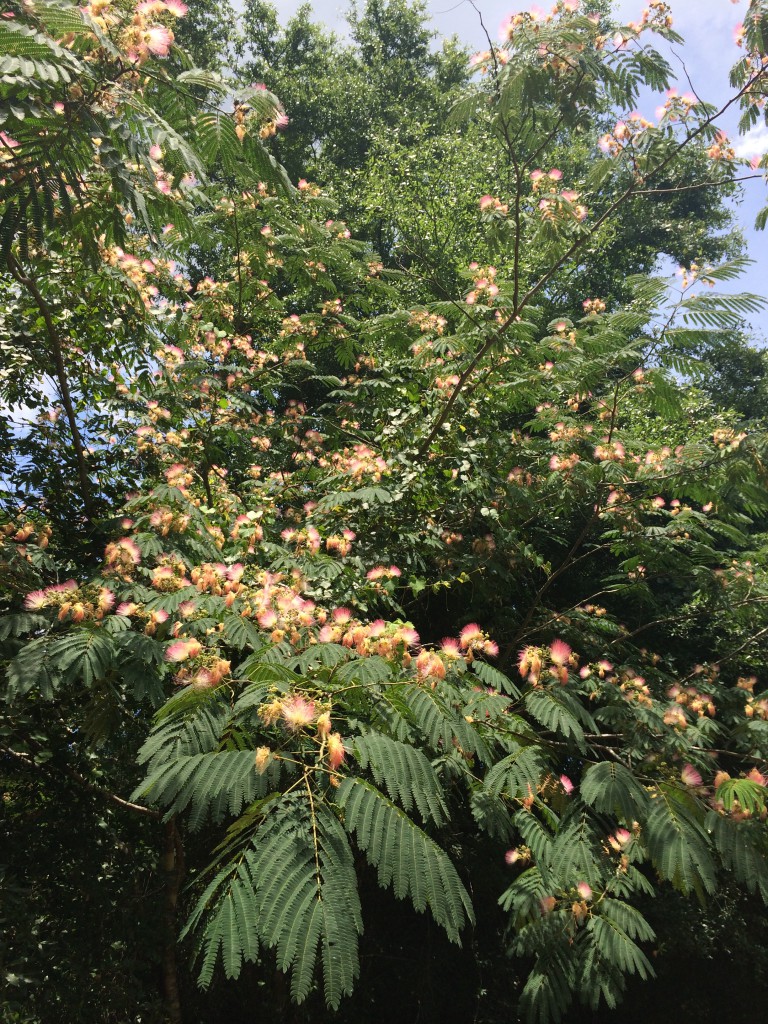
by Rick O'Connor | Aug 27, 2021
Six Rivers “Dirty Dozen” Invasive Species
Mimosa (Albizia julibrissin)
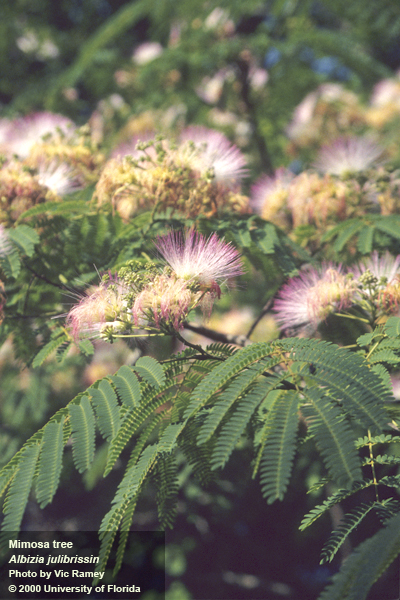
Define Invasive Species: must have all of the following –
- Is non-native to the area, in our case northwest Florida
- Introduced by humans, whether intentional or accidental
- Causing either an environmental or economic problem, possibly both
Define “Dirty Dozen” Species:
These are species that are well established within the CISMA and are considered, by members of the CISMA, to be one of the top 12 worst problems in our area.
Native Range:
Tropical Asia
Introduction:
Intentionally introduced into the United States in 1745 as an ornamental plant. It was popular due to its showy flowers.
EDDMapS currently list 18,546 records of this plant spread across the United States. The vast majority are from the southeastern U.S. 3,323 records are from Florida and 944 within the Six Rivers CISMA. It is most likely under reported.
Description:
This is a small trunked tree with an expanded canopy that reaches about 40 feet in height. It is easily identified by the compounds leaves that can have 20-60 leaflets per branch. The flowers are a brilliant pink and resemble poms-poms. The tree flowers in spring and early summer. Seed pods are present in winter. They are about six inches in length and are light brown in color.
Issues and Impacts:
The primary impact is direct competition with native species. Mimosa does very well in open areas and along the edges of disturbed forested areas. It produces numerous seeds and can take advantage of available native habitats.
Management:
Mechanical removal of saplings is recommended before the plant goes to seed. It is important to remove all roots when pulling by hand to reduce the chance of resprouting.
Chemical treatments (herbicides) will be needed if cutting trees. A 2% solution of glyphosate, or triclopyr, can be used but retreatments may be needed. Application will require a surfactant and contact with the leaves will be enough. 15% Garlon 4, or 100% Pathfinder II, on the bark covering an area of 2 feet can be effective. Trees with trunks larger than 3 inches in diameter may require re-treatment.
There are no known biological controls at this time.
For more information on this Dirty Dozen species, contact your local extension office.
References
Early Detection and Distribution Mapping System (EDDMapS)
https://www.eddmaps.org/
Six Rivers CISMA
https://www.floridainvasives.org/sixrivers/
University of Florida IFAS Assessment
https://assessment.ifas.ufl.edu/assessments/albizia-julibrissin/.
University of Florida Center for Aquatic and Invasive Plants
https://plants.ifas.ufl.edu/plant-directory/albizia-julibrissin/.
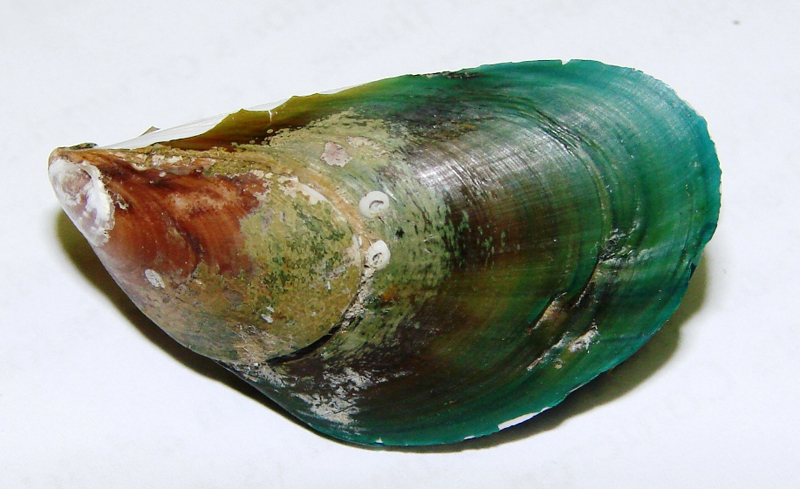
by Rick O'Connor | Aug 11, 2021
EDRR Invasive Species
Green Mussel (Perna viridis)
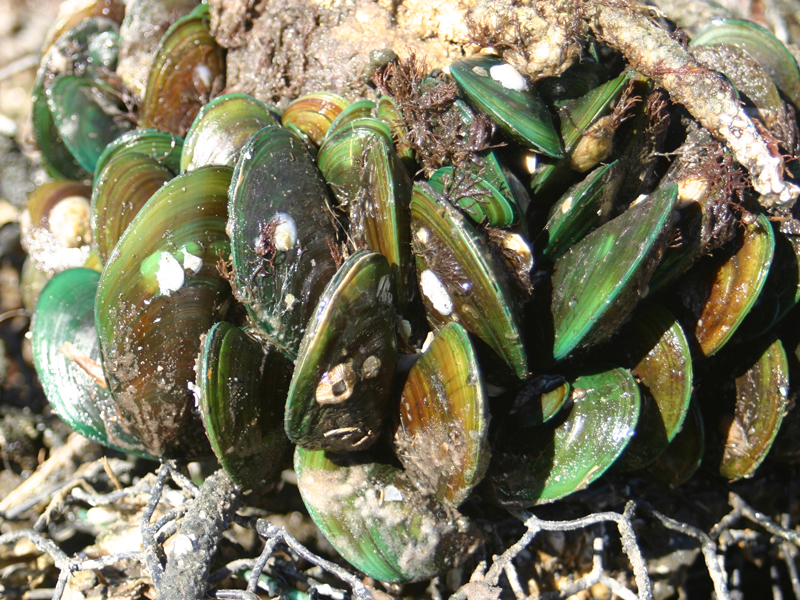
This cluster of green mussels occupies space that could be occupied by bivavles like osyters.
Define Invasive Species: must have ALL of the following –
- Is non-native to the area, in our case northwest Florida
- Introduced by humans, whether intentional or accidental
- Causing either an environmental or economic problem, possibly both
Define EDRR Species: Early Detection Rapid Response. These are species that are either –
- Not currently in the area, in our case the Six Rivers Cooperative Invasive Species Management Area (CISMA), but a potential threat
- In the area but in small numbers and could be eradicated
Native Range:
Green mussels are native to the Indo-Pacific region extending from India to Southeast Asia.
Introduction:
Green mussels have been cultivated as an aquaculture product and were introduced to other parts of the world as such. They were first reported growing wild in the waters of the Caribbean in the 1990s reaching Venezuela by 1993. The first report in Florida was in the Tampa Bay region in 1999. They have been slowly dispersing south along Florida’s Gulf coast. In 2003 they were found on the Atlantic coast near Crescent Beach and the Jacksonville-St. Augustine area. That same year a few single specimens were collected off the coast of Georgia and by 2006 there were records in Charleston SC. There are only a couple records from the Florida panhandle. In 2008 a couple of specimens were reported in the Panama City area and one record in 2011 came from Perdido Key (this one may have been misidentified).
EDDMapS currently list 128 records of green mussels in the U.S. All 128 are from the state of Florida, though the USGS reports one from the state of Washington. There is only one record within the Six Rivers CISMA (that from Pensacola Bay region).
Description:
Mussels are sessile bivalves attached to the substrate using thin byssal threads. This is a large mussel, reaching lengths of 3-4” and some up to 6”. Its shell is not ribbed like our native ribbed mussel often found in salt marshes, but rather smooth and possesses a brilliant emerald green color. In larger/older individuals the green is found more on the margins of the shell with the rest taking on a brownish coloration. The inside of the shell resembles our native mussel in having a bluish iridescent coloration.
Issues and Impacts:
The primary issue with green mussels is fouling. Like zebra mussels, green mussels can foul boat bottoms, overgrow on marina pilings, and clog intake pipes for water treatment and power plant facilities. They can clog crab traps, shellfish aquaculture bags, and will displace native species such as oysters – making oyster restoration projects harder. There is evidence of predation by blue crab and sheepshead, but there does not seem to be enough predation to control populations where they are currently found.
Management:
First, check your boat hull and bilge water before trailering to another water body. It is recommended that you scrap the hull and empty your bilge on land so as not to provide any live material entering the waterways. Be sure you are removing at a location at the ramp where the animals, or even sections of the animals that may contain gametes, cannot reach the waterways during a rain event or other run-of situation.
Second, if found on a seawall or piling, use a paint scraper or flat shovel to remove from such. You want to collect AS MUCH MATERIAL AS YOU CAN into a 5-gallon bucket and remove from the water system. Again, any gamete material remaining could continue the population. At this point you can allow them to dry out and then dispose of.
Third, if in intake pipes there are several methods to remove but many are expensive and options depend on the system that is fouled. It is recommended that you contact your county extension office for advice.
In either case, it is important to report the record to EDDMapS – https://www.eddmaps.org/.
For more information on this EDRR species, contact your local extension office.
References
Dr. Shirley Baker, University of Florida, personal communication.
McGuire, M., J. Stevely. 2018. Invasive Species of Florida’s Coastal Waters: The Asian Green Mussel (Perna viridis). University of Florida IFAS Electronic Data Information System (EDIS). https://edis.ifas.ufl.edu/publication/SG094.
United States Geological Survey. Nonindigenous Aquatic Species Series. Green Mussel (Perna viridis). https://nas.er.usgs.gov/queries/FactSheet.aspx?speciesID=110.
Early Detection and Distribution Mapping System (EDDMapS)
https://www.eddmaps.org/
Six Rivers CISMA
https://www.floridainvasives.org/sixrivers/
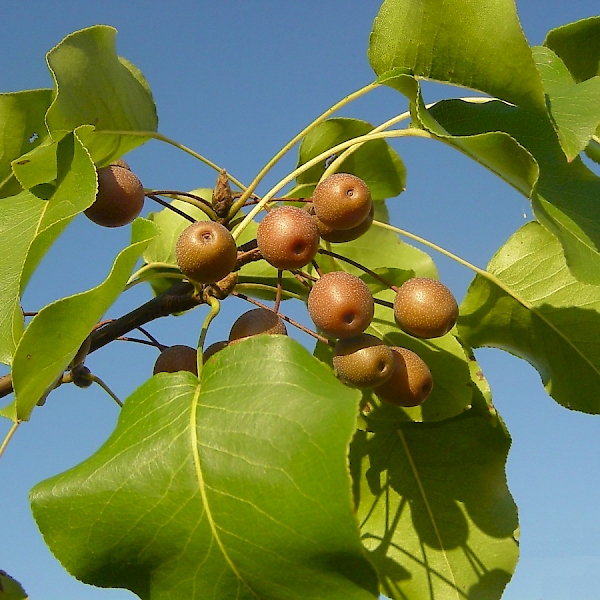
by Rick O'Connor | Jul 27, 2021
Six Rivers “Dirty Dozen” Invasive Species
Callery Pear – Bradford Pear (Pyrus calleryana)

Callery Pear
Photo: University of Florida IFAS
Define Invasive Species: must have all of the following –
- Is non-native to the area, in our case northwest Florida
- Introduced by humans, whether intentional or accidental
- Causing either an environmental or economic problem, possibly both
Define “Dirty Dozen” Species:
These are species that are well established within the CISMA and are considered, by members of the CISMA, to be one of the top 12 worst problems in our area.
Native Range:
Korea and China
Introduction:
The Callery Pear was introduced to the United States in the early 1900s intentionally as an ornamental plant. Its fruits were sterile because they do not self pollinate and spreading was not an issue. New cultivars were produced to reduce the tendency of the tree to split when covered with snow, or in high winds. The ‘Bradford’, and other cultivars, have hybridized with the Asian Pear (P. betulifolia) and produced fertile fruit that have spread into natural areas and become an ecological problem.
EDDMapS currently list 6,112 records of this plant spread across the United States. 1,837 are listed in the southeastern United States and 164 of those are in Florida. All 164 are found within the Six Rivers CISMA in Santa Rosa and Okaloosa counties. It is most likely under reported.
Description:
It is a tree that can reach 50 feet in height. It grows very quickly and the branches are close together forming a dense round-ish canopy. The leaves are glossy, simple, ovate in shape, serrated on the edges, and alternate on the branch. It is a deciduous and will turn all sorts of colors in the fall. It produces a beautiful white blossom tinged in pink. It does produce an aroma that some find unpleasant. The fruits are round, about 0.5-1.0” in diameter, and golden brown in color. The bark is dark to light brown in color and very smooth to the touch.
Issues and Impacts:
The primary issue with the Bradford cultivar is the ecological problems it has caused in natural areas. The University of Florida IFAS Assessment considers it a high risk as an invasive species.
Management:
Trees should be cut down and stumps treated with either glyphosate or triclopyr products. Multiple treatments will be needed.
For more information on this Dirty Dozen species, contact your local extension office.
References
Callery (Bradford) Pear. Invasive Plant Atlas of the United States. https://www.invasiveplantatlas.org/subject.html?sub=10957.
Early Detection and Distribution Mapping System (EDDMapS)
https://www.eddmaps.org/
Gilman, E.F., D.G. Watson, R.W. Klein, A.K. Koeser, D.R. Hilbert, D.C. McClean. Pyrus calleryana, “Bradford” Callery Pear. University of Florida Electronic Data Information System publication.
https://edis.ifas.ufl.edu/pdf/ST/ST53700.pdf.
Six Rivers CISMA
https://www.floridainvasives.org/sixrivers/
University of Florida IFAS Assessment
https://assessment.ifas.ufl.edu/assessments/pyrus-calleryana/
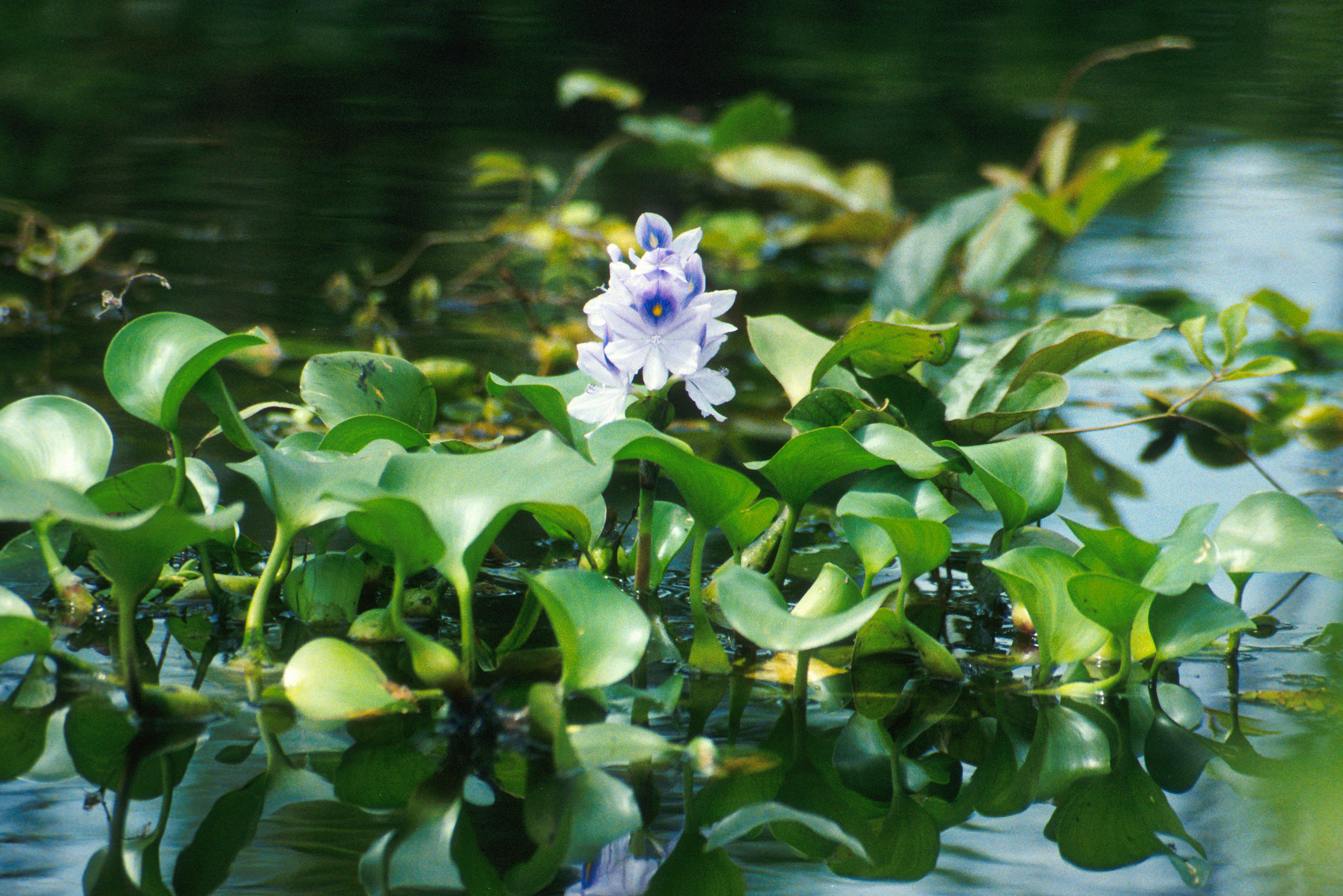
by Rick O'Connor | Jul 22, 2021
EDRR Invasive Species
Water Hyacinth (Eichhornia crassipes)
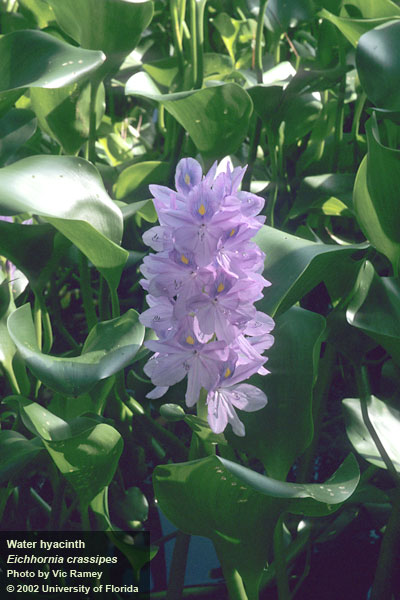
Water Hyacinth Photo Credit: Vic Ramey, UF/IFAS
Define Invasive Species: must have ALL of the following –
- Is non-native to the area, in our case northwest Florida
- Introduced by humans, whether intentional or accidental
- Causing either an environmental or economic problem, possibly both
Define EDRR Species: Early Detection Rapid Response. These are species that are either –
- Not currently in the area, in our case the Six Rivers CISMA, but a potential threat
- In the area but in small numbers and could be eradicated
Native Range:
Water hyacinth is native to South America.
Introduction:
It was introduced intentionally by horticulturists in 1884 at the Cotton States Exposition in New Orleans.
EDDMapS currently list 15,051 records of water hyacinth in the U.S. These records are scattered across the country with over 12,000 coming from the state of California. There are 1,229 reported from the southeastern U.S., which is certainly under reported, and 784 in Florida, also under reported – though resource managers indicate that amount of water hyacinth in Florida has decreased with management efforts. There are 13 records reported from the Six Rivers CISMA. This is assumed to be under reported but suggest the plant is correctly listed as an EDRR species and spread could be stopped. Three are from the Mobile delta area, one from Fairhope AL, and the remaining in Okaloosa County.
Description:
This is a perennial free floating freshwater aquatic plant, with long dark roots. The leaves form rosettes and the petioles can be 12” in length. They are bulbous and inflated, particularly near the base. The leaves are a deep green and glossy looking. They can be six inches wide and elliptic in shape.
The flowers extend above the rosette. They are lavender and blue with a flash of yellow. The flower can be 12” tall and 2” across.
Issues and Impacts:
The plant can form extremely dense floating mats making boating, fishing, or any other water recreation impossible. These dense mats can inhibit the growth of other native plants, reducing certain aquatic animals, and overall decreasing biodiversity. The mats reduce air-water oxygen exchange reducing dissolved oxygen as well as block sunlight reducing the development of many submerged aquatic vegetation. Again, reducing the systems overall biodiversity.
Management:
Small patches in local ponds and lakes can easily be removed by hand.
For large infestations there are large mechanical mowers/choppers that can be used to remove from the waterway. The remains can be further chopped and disposed of.
There are herbicides that can be used but these must be ones approved by both the U.S. EPA and FDACS for use in aquatic systems. The labels will state this. It is illegal to do so otherwise. Care should be taken when selecting herbicides for aquatic use considering other important aquatic plants and toxicity to aquatic animals such as fish. Diquat is considered an excellent choice. Carfentrazone and copper are considered fair. Others are not recommended. NOTE: these herbicides do not always completely eradicate the plant and windy conditions can make treatments a problem. The EDIS publication referenced below is a helpful resource to begin review of chemical treatment, and you can always contact your county extension office for more advice before using aquatic herbicides.
For more information on this EDRR species, contact your local extension office.
References
Water Hyacinth, Eichhornia crassipes
University of Florida IFAS Center for Aquatic and Invasive Plants
https://plants.ifas.ufl.edu/plant-directory/eichhornia-crassipes/
Efficacy of Herbicide Active Ingredients Against Aquatic Weeds.
Enloe, S.F., M.D. Netherland, W. Haller, and K. Langeland.
University of Florida IFAS Electronic Data Information Service (EDIS)
https://edis.ifas.ufl.edu/publication/ag262.
Early Detection and Distribution Mapping System (EDDMapS)
https://www.eddmaps.org/
Six Rivers CISMA
https://www.floridainvasives.org/sixrivers/
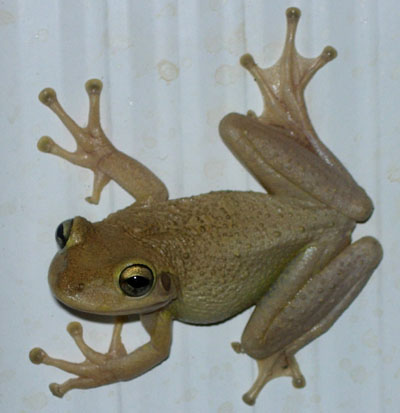
by Sheila Dunning | Jul 15, 2021
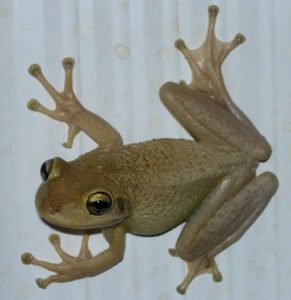
Photo by: Dr. Steve Johnson
Treefrog calls are often heard with each rain event. But, how about a “snoring raspy” call that begins after a day time light rain? That may be a male Cuban treefrog trying to attract the girls. Cuban treefrogs breed predominately in the spring and summer. Reproduction is largely stimulated by rainfall, especially warm summer rains such as those associated with tropical weather systems and intense thunderstorms.
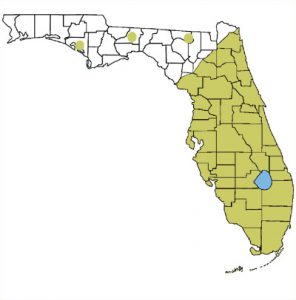
Range of Cuban treefrog
The Cuban treefrog, Osteopilus septentrionalis, was accidently introduced to Florida in the 1920’s as a stowaway in shipping crates from the Caribbean. Over the last hundred years, the invasive frog has managed to spread throughout Florida and the Southeastern U.S. by hitchhiking on ornamental plants, motorized vehicles and boats. Though occasional cold winters have created temporary population setbacks, new generations of Cuban treefrogs continue to be reported in north Florida, including the Panhandle.
An invasive species is generally defined as a plant, animal or microbe that is found outside od its native range, where it negatively impacts the ecology, economy or quality of human life. Cuban treefrogs come out at night to feed on snails, millipedes, spiders and a vast array of insects. But, they are also predators of several Florida native frogs, lizards and snakes. Tadpoles of the invasive Cuban treefrog have been shown to inhibit the growth and development of native Southern toad and green treefrog tadpoles when all of the species are in the same water body. Additionally, a large female Cuban treefrog can lay over 10,000 eggs per season in very small amounts of water.
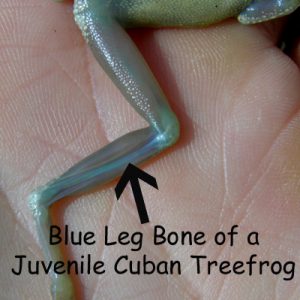 Panhandle citizens can help manage the invasive Cuban treefrog by learning to identify them and reduce their numbers. All treefrogs have expanded pads on the ends of their toes. Cuban treefrogs have exceptionally large toepads. They also have a “big eyed” appearance due to their oversized bulging eyes. Cuban treefrogs may exceed 6 inches in length, have warty-looking skin with possible blotches, bands or stripes, and vary greatly in color. However, they can be distinguished from other treefrogs. Cuban treefrogs have a yellowish wash where their front and rear legs are attached to their body. Juvenile Cuban treefrogs have red eyes and blue bones visible through the skin of their hind legs. The skin of the Cuban treefrog produces a sticky secretion that can cause a burning or itching sensation if it contacts the eyes or nose of certain individuals. It is recommended to wear gloves and wash your hands after handling Cuban treefrogs.
Panhandle citizens can help manage the invasive Cuban treefrog by learning to identify them and reduce their numbers. All treefrogs have expanded pads on the ends of their toes. Cuban treefrogs have exceptionally large toepads. They also have a “big eyed” appearance due to their oversized bulging eyes. Cuban treefrogs may exceed 6 inches in length, have warty-looking skin with possible blotches, bands or stripes, and vary greatly in color. However, they can be distinguished from other treefrogs. Cuban treefrogs have a yellowish wash where their front and rear legs are attached to their body. Juvenile Cuban treefrogs have red eyes and blue bones visible through the skin of their hind legs. The skin of the Cuban treefrog produces a sticky secretion that can cause a burning or itching sensation if it contacts the eyes or nose of certain individuals. It is recommended to wear gloves and wash your hands after handling Cuban treefrogs.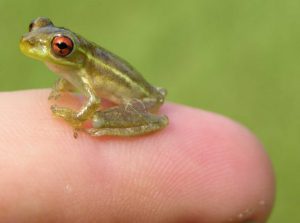
It is important to document the locations of Cuban treefrogs in the Panhandle. By placing short sections of PVC pipe in the ground around your home and garden will provide hiding places for treefrogs that enables you to monitor for Cuban treefrogs. Cut 10 foot sections of 1.5-inch-diameter PVC pipe into approximately three-foot-long sections and push them into the ground about 3-4 inches. To remove a frog from a pipe, place a clear sandwich bag over the top end, pull the pipe from the ground, and insert a dowel rod in the other end to scare the frog into the baggie. If you suspect you have seen one, take a picture and send it to Dr. Steve Johnson at tadpole@ufl.edu. Include your name, date, and location. Dr. Johnson can verify the identity. If it is a Cuban treefrog, upload the information by going to http://www.eddmaps.org/ and click the “Report Sightings” tab.
Once identified as a Cuban treefrog, it should be euthanized humanly. To do that, the Cuban treefrog in a plastic sandwich bag can be placed into the refrigerator for 3-4 hours then transferred to the freezer for an additional 24 hours. Alternatively, a 1-inch stripe benzocaine-containing ointment (like Orajel) to the frog’s back to chemically anesthetize it before placing it into a freezer. After freezing, remove the bagged frog from the freezer and dispose of in the trash. Ornamental ponds should also be monitored for Cuban treefrog egg masses especially after a heavy rain. The morning after a rain, use a small-mesh aquarium net to scoop out masses of eggs floating on the surface of the pond and simply discard them on the ground to dry out. Various objects that can collect water found throughout your yard need to be dumped out regularly to reduce breeding spots for both Cuban treefrogs and mosquitoes.













